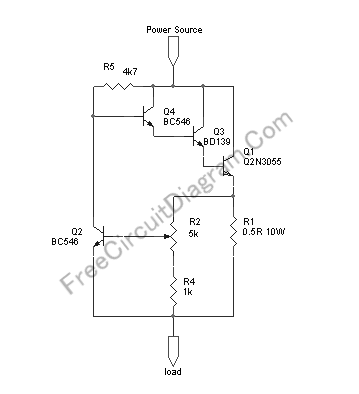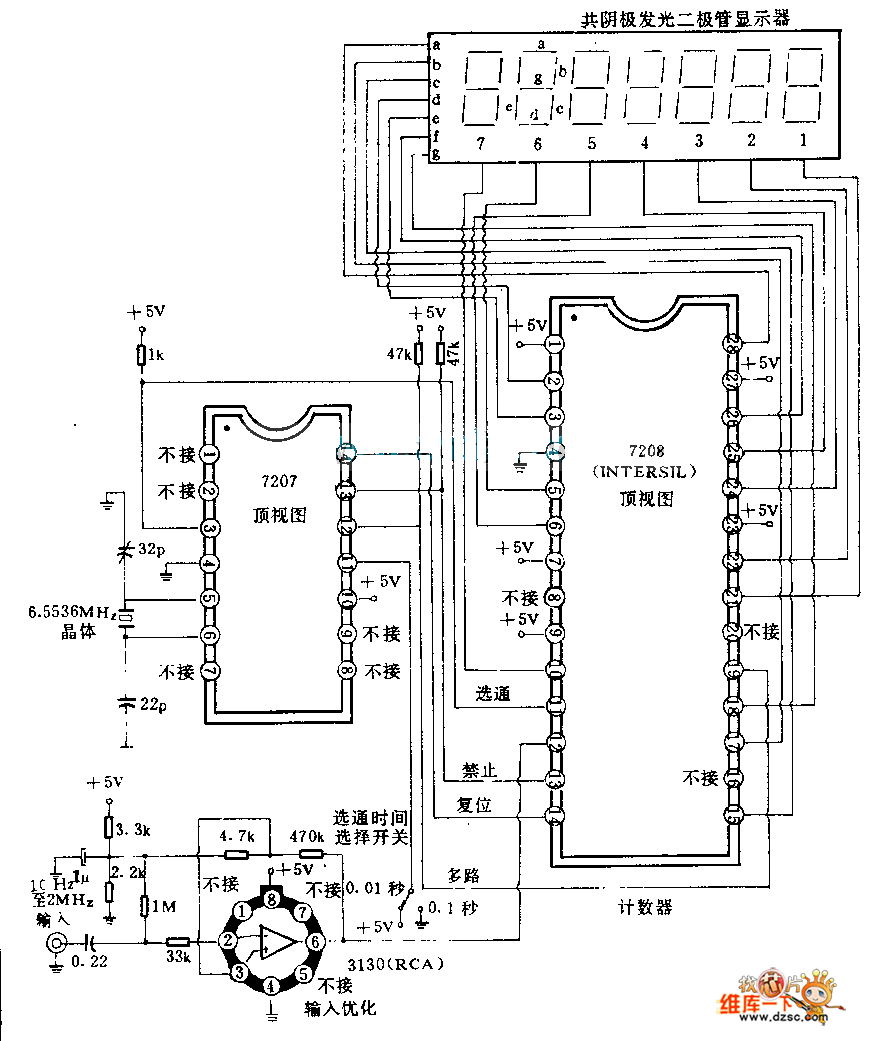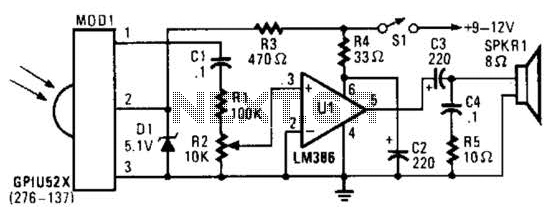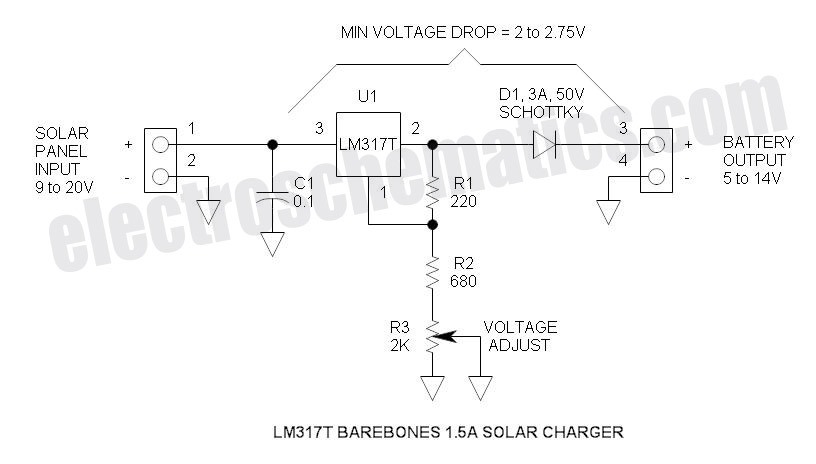
An Introduction To Verilog Circuit

The schematic closely resembles the one found in the CPLD Development Board Tutorial, as it is essentially the same board with a minor addition. The new components are located in the lower right corner, including eight DIP switches, a resistor array, and some additional wiring. It is important to note the pins to which the switches are connected on the CPLD, as these will be significant later when selecting I/O pins in the programming phase. The power circuit consists of a 9V battery connected to an LM7805 voltage regulator, with several capacitors attached to the output and ground of the LM7805 to maintain a stable 5V DC output. The programming circuit features a shrouded header with 10 pins, which serves as a standard JTAG header. This header will be utilized to program the CPLD using the ByteBlaster MV cable. It is crucial to verify the wiring in this section of the board to avoid damaging the ByteBlaster cable. The 7-segment LED display is connected to seven pins numbered 61-70 on the CPLD, which control the illumination of the LEDs within the display. For this project, a simple program will be created to light up all the segments, without any complex functionality. The 100-ohm resistors preceding the display function as current limiting resistors, allowing the user to provide input and ultimately determine what is displayed on the 7-segment LED display. Depending on which bit is set, the corresponding number will be shown (1->1, 2->2, etc.).
The schematic integrates various components that enhance the functionality of the CPLD development board. The inclusion of eight DIP switches offers a straightforward method for user input, facilitating the selection of different operational modes or configurations. Each switch connects to designated I/O pins on the CPLD, enabling the programming of specific actions based on the switch positions.
The power supply section is designed to ensure reliable operation of the circuit. The 9V battery feeds into the LM7805 voltage regulator, which outputs a steady 5V DC. The addition of capacitors at the output and ground of the LM7805 serves to filter any voltage fluctuations, thereby maintaining stable power to the CPLD and associated components.
The programming interface, utilizing a shrouded 10-pin JTAG header, is a critical component for uploading configurations and programs to the CPLD. Careful attention to wiring in this section is essential, as incorrect connections could lead to permanent damage to the programming hardware.
The 7-segment LED display is a key output device in this schematic, providing a visual representation of the data processed by the CPLD. The connection of the display to pins 61-70 allows for direct control over each segment, making it possible to display numerical values based on the input from the DIP switches. The current limiting resistors are crucial for protecting the LEDs from excessive current, thus ensuring longevity and reliable operation.
Overall, the schematic represents a well-thought-out design that incorporates essential features for both input and output, making it suitable for various applications in digital logic design and prototyping.The schematic is very similar to the one seen in the CPLD Development Board Tutorial because it`s basically the same board with a tiny addition. The new part of the schematic is in the lower right corner. 8 (DIP) Switches, a resistor array & some additional wiring. Notice the pins that the switches are connected to on the CPLD, these will be impor tant later on when you choose I/O pins in the program. The power circuit is a 9v Battery hooked up to the LM7805 with several capacitors attached to output & ground of the LM7805 to keep a steady 5v DC. The programming circuit uses a "shrouded header" with 10 pins. This is a standard JTAG header. We will use this to program the CPLD with the ByteBlaster MV cable. Double check the wiring on this part of the board otherwise you might fry your ByteBlaster cable! The 7 segment led display is wired up to 7 pins between 61-70 on the CPLD. These 7 pins control which leds are lit up inside the display. For our purposes in this project we`ll only make a simple program that lights them all up, nothing too fancy.
The 100 resistors that precede the display are just current limiting resistors. These allow the user to give input and ultimately decide what is to be displayed on the 7-Segment LED Display. Depending upon which bit is set, the corresponding number will be displayed on the display (1->1, 2->2, etc.
). 🔗 External reference
The schematic integrates various components that enhance the functionality of the CPLD development board. The inclusion of eight DIP switches offers a straightforward method for user input, facilitating the selection of different operational modes or configurations. Each switch connects to designated I/O pins on the CPLD, enabling the programming of specific actions based on the switch positions.
The power supply section is designed to ensure reliable operation of the circuit. The 9V battery feeds into the LM7805 voltage regulator, which outputs a steady 5V DC. The addition of capacitors at the output and ground of the LM7805 serves to filter any voltage fluctuations, thereby maintaining stable power to the CPLD and associated components.
The programming interface, utilizing a shrouded 10-pin JTAG header, is a critical component for uploading configurations and programs to the CPLD. Careful attention to wiring in this section is essential, as incorrect connections could lead to permanent damage to the programming hardware.
The 7-segment LED display is a key output device in this schematic, providing a visual representation of the data processed by the CPLD. The connection of the display to pins 61-70 allows for direct control over each segment, making it possible to display numerical values based on the input from the DIP switches. The current limiting resistors are crucial for protecting the LEDs from excessive current, thus ensuring longevity and reliable operation.
Overall, the schematic represents a well-thought-out design that incorporates essential features for both input and output, making it suitable for various applications in digital logic design and prototyping.The schematic is very similar to the one seen in the CPLD Development Board Tutorial because it`s basically the same board with a tiny addition. The new part of the schematic is in the lower right corner. 8 (DIP) Switches, a resistor array & some additional wiring. Notice the pins that the switches are connected to on the CPLD, these will be impor tant later on when you choose I/O pins in the program. The power circuit is a 9v Battery hooked up to the LM7805 with several capacitors attached to output & ground of the LM7805 to keep a steady 5v DC. The programming circuit uses a "shrouded header" with 10 pins. This is a standard JTAG header. We will use this to program the CPLD with the ByteBlaster MV cable. Double check the wiring on this part of the board otherwise you might fry your ByteBlaster cable! The 7 segment led display is wired up to 7 pins between 61-70 on the CPLD. These 7 pins control which leds are lit up inside the display. For our purposes in this project we`ll only make a simple program that lights them all up, nothing too fancy.
The 100 resistors that precede the display are just current limiting resistors. These allow the user to give input and ultimately decide what is to be displayed on the 7-Segment LED Display. Depending upon which bit is set, the corresponding number will be displayed on the display (1->1, 2->2, etc.
). 🔗 External reference




